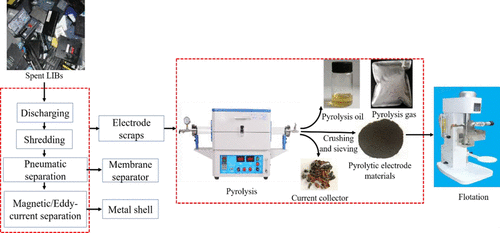当前位置:
X-MOL 学术
›
ACS Sustain. Chem. Eng.
›
论文详情
Our official English website, www.x-mol.net, welcomes your
feedback! (Note: you will need to create a separate account there.)
Removal of Organics by Pyrolysis for Enhancing Liberation and Flotation Behavior of Electrode Materials Derived from Spent Lithium-Ion Batteries
ACS Sustainable Chemistry & Engineering ( IF 7.1 ) Pub Date : 2020-01-30 , DOI: 10.1021/acssuschemeng.9b05896 Guangwen Zhang 1 , Yaqun He 2, 3 , Haifeng Wang 3 , Yi Feng 3 , Weining Xie 2 , Xiangnan Zhu 4
ACS Sustainable Chemistry & Engineering ( IF 7.1 ) Pub Date : 2020-01-30 , DOI: 10.1021/acssuschemeng.9b05896 Guangwen Zhang 1 , Yaqun He 2, 3 , Haifeng Wang 3 , Yi Feng 3 , Weining Xie 2 , Xiangnan Zhu 4
Affiliation

|
Organics retained in electrode materials decrease the liberation and flotation efficiency of electrode materials. The pyrolysis-assisted sustainable process was used to remove the organic binder and residual electrolyte that were wrapped on the surface of electrode particles for enhancing liberation efficiency and flotation behavior of electrode materials. The pyrolysis characteristics of organics in electrode materials were investigated. A high-resolution three-dimensional X-ray microanalyzer combined with a scanning electron microscope was utilized to reveal the liberation enhancement mechanism of electrode materials. Afterward, effects of pyrolysis on surface morphology and flotation behavior of electrode materials were evaluated. Pyrolysis characteristics demonstrate that organics can be adequately decomposed at a pyrolysis temperature of 500 °C resulting in a high liberation efficiency with a shorter crushing time. However, some pyrolysis oils remain on the surface of electrode materials at a pyrolysis temperature of 500 °C, which decrease flotation efficiency of electrode materials. Contact angle analysis indicates that the optimum flotation results are presented at a pyrolysis temperature of 550 °C due to the removal of residual pyrolysis oils and the cathode grade is up to 94.72% with a recovery of 83.75% in this condition. Wet-ball grinding can further improve cathode recovery from 83.75 to 91.35% by removing residual pyrolytic carbon.
中文翻译:

通过热解去除有机物,以增强废锂离子电池电极材料的释放和浮选行为
保留在电极材料中的有机物会降低电极材料的释放和浮选效率。使用热解辅助可持续工艺去除包裹在电极颗粒表面的有机粘合剂和残留电解质,以提高电极材料的释放效率和浮选性能。研究了电极材料中有机物的热解特性。高分辨率三维X射线微分析仪结合扫描电子显微镜被用来揭示电极材料的释放增强机理。随后,评估了热解对电极材料的表面形态和浮选行为的影响。热解特性表明,有机物可在500°C的热解温度下充分分解,从而产生较高的释放效率,并缩短了破碎时间。然而,在500℃的热解温度下,一些热解油残留在电极材料的表面上,这降低了电极材料的浮选效率。接触角分析表明,由于去除了残留的热解油,在550°C的热解温度下呈现了最佳浮选结果,在这种条件下,阴极品位高达94.72%,回收率达到83.75%。湿球研磨可通过除去残留的热解碳进一步将阴极回收率从83.75提高到91.35%。在500°C的热解温度下,一些热解油会残留在电极材料的表面,这会降低电极材料的浮选效率。接触角分析表明,由于去除了残留的热解油,在550°C的热解温度下呈现了最佳浮选结果,在这种条件下,阴极品位高达94.72%,回收率达到83.75%。湿球研磨可通过除去残留的热解碳进一步将阴极回收率从83.75提高到91.35%。在500°C的热解温度下,一些热解油会残留在电极材料的表面,这会降低电极材料的浮选效率。接触角分析表明,由于去除了残留的热解油,在550°C的热解温度下呈现了最佳浮选结果,在这种条件下,阴极品位高达94.72%,回收率达到83.75%。湿球研磨可通过除去残留的热解碳进一步将阴极回收率从83.75提高到91.35%。在这种情况下恢复率为72.5%,达到72%。湿球研磨可通过除去残留的热解碳进一步将阴极回收率从83.75提高到91.35%。在这种情况下恢复率为72.5%,达到72%。湿球研磨可通过除去残留的热解碳进一步将阴极回收率从83.75提高到91.35%。
更新日期:2020-01-31
中文翻译:

通过热解去除有机物,以增强废锂离子电池电极材料的释放和浮选行为
保留在电极材料中的有机物会降低电极材料的释放和浮选效率。使用热解辅助可持续工艺去除包裹在电极颗粒表面的有机粘合剂和残留电解质,以提高电极材料的释放效率和浮选性能。研究了电极材料中有机物的热解特性。高分辨率三维X射线微分析仪结合扫描电子显微镜被用来揭示电极材料的释放增强机理。随后,评估了热解对电极材料的表面形态和浮选行为的影响。热解特性表明,有机物可在500°C的热解温度下充分分解,从而产生较高的释放效率,并缩短了破碎时间。然而,在500℃的热解温度下,一些热解油残留在电极材料的表面上,这降低了电极材料的浮选效率。接触角分析表明,由于去除了残留的热解油,在550°C的热解温度下呈现了最佳浮选结果,在这种条件下,阴极品位高达94.72%,回收率达到83.75%。湿球研磨可通过除去残留的热解碳进一步将阴极回收率从83.75提高到91.35%。在500°C的热解温度下,一些热解油会残留在电极材料的表面,这会降低电极材料的浮选效率。接触角分析表明,由于去除了残留的热解油,在550°C的热解温度下呈现了最佳浮选结果,在这种条件下,阴极品位高达94.72%,回收率达到83.75%。湿球研磨可通过除去残留的热解碳进一步将阴极回收率从83.75提高到91.35%。在500°C的热解温度下,一些热解油会残留在电极材料的表面,这会降低电极材料的浮选效率。接触角分析表明,由于去除了残留的热解油,在550°C的热解温度下呈现了最佳浮选结果,在这种条件下,阴极品位高达94.72%,回收率达到83.75%。湿球研磨可通过除去残留的热解碳进一步将阴极回收率从83.75提高到91.35%。在这种情况下恢复率为72.5%,达到72%。湿球研磨可通过除去残留的热解碳进一步将阴极回收率从83.75提高到91.35%。在这种情况下恢复率为72.5%,达到72%。湿球研磨可通过除去残留的热解碳进一步将阴极回收率从83.75提高到91.35%。











































 京公网安备 11010802027423号
京公网安备 11010802027423号